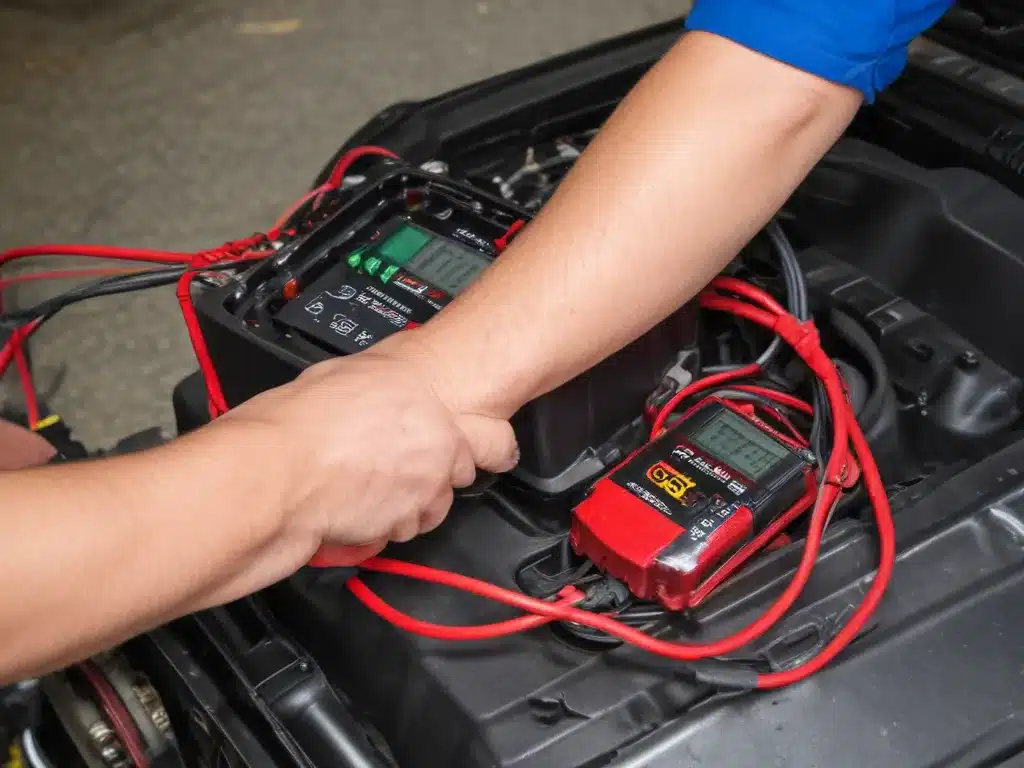
Unlocking the Mysteries of Your Car’s Electrical Heartbeat
Picture this – you’re driving down the highway, jamming out to your favorite tunes, when suddenly your dashboard lights up like a Christmas tree. The battery light is on, and your engine seems to be struggling. Uh oh, Houston, we have a problem. What could be causing this electrical meltdown, and more importantly, how do you fix it?
As an avid DIY car enthusiast, I’ve been there more times than I’d like to admit. But over the years, I’ve learned a thing or two about diagnosing and repairing those pesky charging system issues. And let me tell you, it’s a whole lot easier than you might think.
Understanding the Charge: The Basics of Your Car’s Electrical System
Let’s start with the basics, shall we? Your car’s electrical system is kind of like the heart and circulatory system of your trusty four-wheeled steed. It’s responsible for powering everything from your headlights to your heated seats, and it all starts with the charging system.
The charging system has three main components: the battery, the alternator, and the voltage regulator. The battery stores the electrical energy needed to start your car and power all those electrical goodies. The alternator is the generator that recharges the battery while you’re driving. And the voltage regulator, well, it keeps things running smoothly by maintaining a steady voltage output.
So, when one of these components starts to fail, it can cause all sorts of electrical mayhem. Your battery might not be holding a charge, your alternator might be underperforming, or your voltage regulator could be on the fritz. The end result? A dashboard that looks like a Vegas light show and a car that’s about as reliable as a politician’s promise.
Diagnosing the Dilemma: Step-by-Step Troubleshooting
Okay, now that we’ve got the basics down, let’s dive into the nitty-gritty of diagnosing a charging system issue. The first step is to grab your trusty multimeter and start taking some readings.
First, check the battery voltage with the engine running. It should be in the range of 13.5 to 14.5 volts. If it’s not, that could be a sign of a problem with the alternator or voltage regulator.
Next, test the alternator’s output voltage. With the engine running, you should see a voltage between 13.5 and 14.5 volts. If it’s significantly lower than that, your alternator might be on its last legs.
Finally, check the voltage drop across the charging system. This basically tells you how much resistance there is in the system. You should see less than 0.5 volts of drop from the alternator to the battery. Anything higher than that, and you might have a wiring issue or a bad connection somewhere.
Now, if all those readings check out, the problem could be a little trickier to diagnose. Maybe your voltage regulator is malfunctioning, or there’s a problem with the electrical load on the system. In those cases, you might need to do a little deeper digging.
Fixing the Fiasco: DIY Repair and Maintenance
Alright, so you’ve done the diagnostic dance and you know where the problem lies. Now it’s time to roll up those sleeves and get to work. Luckily, charging system repairs are often relatively straightforward, even for the DIY-inclined.
Let’s say your alternator is the culprit. Replacing an alternator is a pretty straightforward job – you just need to disconnect the battery, remove a few bolts, and swap in the new one. It’s a good idea to also replace the serpentine belt while you’re at it, just to be on the safe side.
On the other hand, if it’s a voltage regulator issue, that’s an even easier fix. In many cases, you can simply unplug the old one and plug in a new one. Just make sure to get the right replacement for your vehicle.
And don’t forget about regular maintenance! Keeping your charging system in tip-top shape is key to avoiding those sudden electrical meltdowns. That means checking your battery connections, inspecting the alternator belt, and having your system tested periodically.
Conclusion: Empowered and Electrified
There you have it, folks – the ins and outs of DIY charging system diagnosis and repair. With a little know-how and a trusty multimeter, you can tackle those pesky electrical issues like a pro.
Remember, a healthy charging system is the heart of your car’s electrical wellbeing. Keep it in tip-top shape, and you’ll be cruising down the road with confidence, jamming out to your tunes without a care in the world.
So, what are you waiting for? Get out there, get your hands dirty, and take control of your car’s electrical destiny. Trust me, it’s a whole lot more satisfying than waiting around for the mechanic to fix it. Happy charging!


